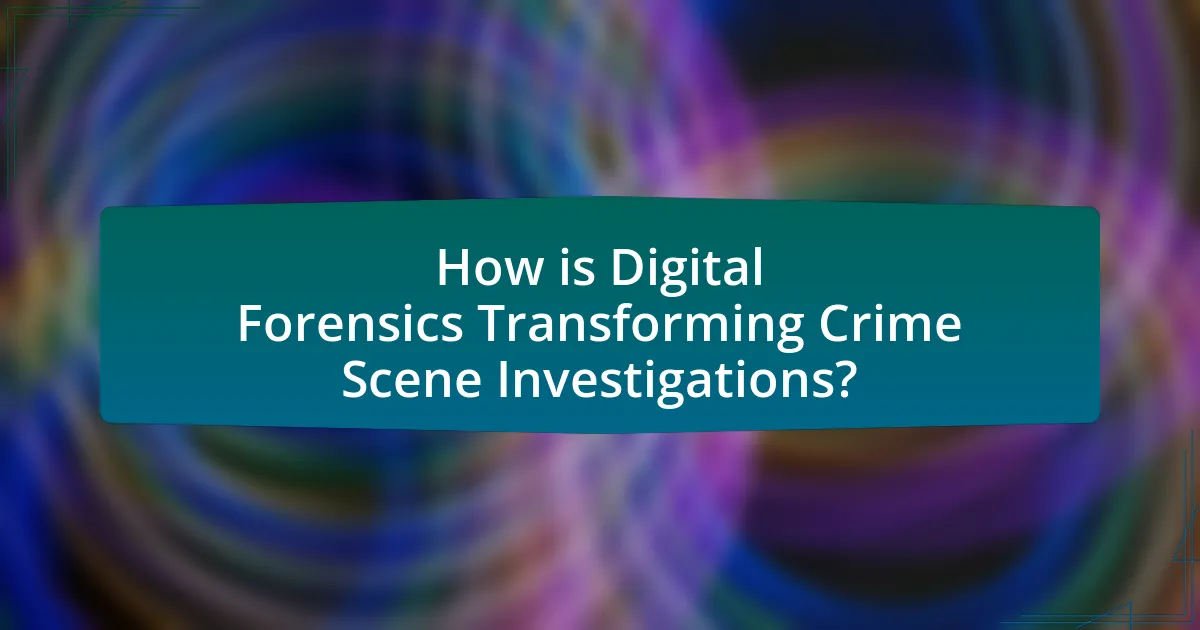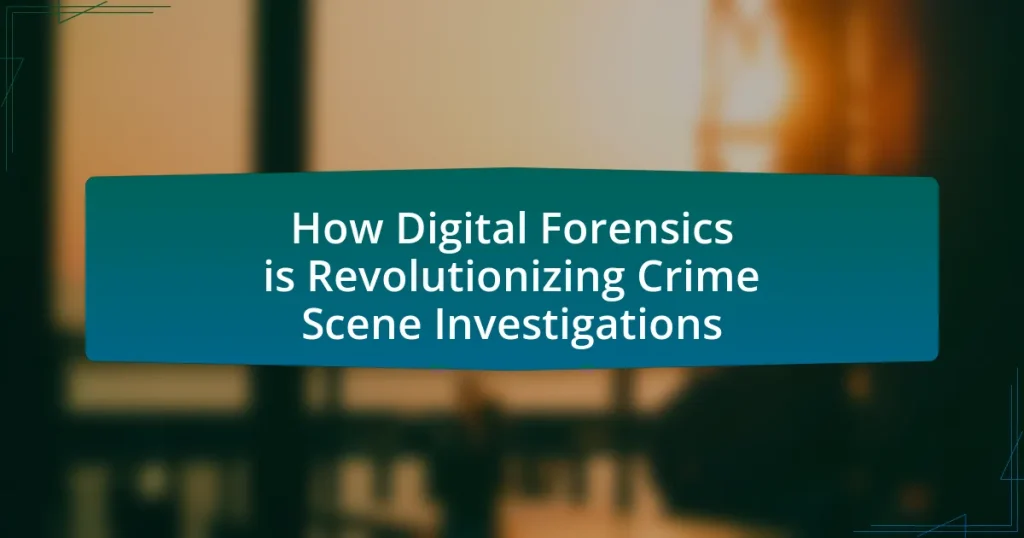Digital forensics is revolutionizing crime scene investigations by enabling the recovery and analysis of digital evidence from electronic devices, which is crucial for establishing connections between suspects and victims. Key principles of digital forensics include evidence preservation, data integrity, and meticulous documentation, ensuring that digital evidence is reliable and admissible in court. Unlike traditional forensic methods that focus on physical evidence, digital forensics targets electronic data, employing specialized technologies for data recovery and analysis. The article explores the essential technologies used in digital forensics, its critical role in modern investigations, and the future trends influenced by advancements such as artificial intelligence, highlighting the importance of best practices and training for effective application in the field.

How is Digital Forensics Transforming Crime Scene Investigations?
Digital forensics is transforming crime scene investigations by enabling the recovery and analysis of digital evidence from electronic devices, which can provide critical insights into criminal activities. This transformation is evident as law enforcement agencies increasingly rely on digital data, such as emails, social media interactions, and GPS location data, to establish timelines and connections between suspects and victims. For instance, a study by the National Institute of Justice highlights that digital evidence can significantly enhance the investigative process, leading to higher conviction rates. Furthermore, the integration of advanced forensic tools allows for the extraction of data even from damaged or encrypted devices, thereby expanding the scope of evidence available to investigators.
What are the key principles of Digital Forensics?
The key principles of Digital Forensics include the preservation of evidence, the integrity of data, and the documentation of processes. Preservation of evidence ensures that digital data is collected and stored without alteration, which is critical for maintaining its admissibility in court. The integrity of data involves using methods such as hashing to verify that the data remains unchanged during analysis. Documentation of processes is essential for creating a clear chain of custody and providing a transparent account of the forensic investigation, which is vital for legal proceedings. These principles are foundational to ensuring that digital evidence is reliable and can withstand scrutiny in judicial contexts.
How does Digital Forensics differ from traditional forensic methods?
Digital forensics differs from traditional forensic methods primarily in its focus on electronic data recovery and analysis rather than physical evidence collection. While traditional forensics often involves gathering tangible items like fingerprints, blood samples, or weapons from a crime scene, digital forensics specifically targets data stored on electronic devices such as computers, smartphones, and servers. This distinction is crucial as digital forensics employs specialized techniques to extract, preserve, and analyze digital evidence, which can include emails, files, and metadata, often leading to insights that are not available through conventional methods. The rise of technology in criminal activities necessitates this specialized approach, as evidenced by the increasing number of cases where digital evidence plays a pivotal role in investigations and prosecutions.
What technologies are essential in Digital Forensics?
Essential technologies in Digital Forensics include disk imaging tools, data recovery software, and forensic analysis suites. Disk imaging tools, such as FTK Imager and EnCase, create exact copies of storage devices, preserving data integrity for analysis. Data recovery software, like Recuva and R-Studio, retrieves deleted files, which can be crucial in investigations. Forensic analysis suites, such as Autopsy and X1 Social Discovery, provide comprehensive tools for analyzing digital evidence, including file carving and timeline analysis. These technologies are vital for ensuring accurate and reliable investigations in the field of Digital Forensics.
Why is Digital Forensics crucial in modern investigations?
Digital forensics is crucial in modern investigations because it enables the recovery and analysis of electronic data that can serve as vital evidence in criminal cases. With the increasing reliance on digital devices, such as smartphones and computers, investigators can uncover critical information, including communications, location data, and digital footprints, which can link suspects to crimes or exonerate the innocent. For instance, a study by the National Institute of Justice highlights that digital evidence is involved in over 90% of criminal cases today, underscoring its importance in establishing timelines and corroborating witness statements.
How does Digital Forensics enhance evidence collection?
Digital forensics enhances evidence collection by systematically recovering, analyzing, and preserving digital data from various devices. This process allows investigators to obtain crucial information such as emails, documents, and metadata that can establish timelines and connections relevant to a case. For instance, studies show that over 90% of criminal investigations now involve digital evidence, highlighting its significance in modern law enforcement. By employing specialized tools and methodologies, digital forensics ensures that the integrity of the evidence is maintained, making it admissible in court and increasing the likelihood of successful prosecutions.
What role does Digital Forensics play in solving cybercrimes?
Digital Forensics plays a critical role in solving cybercrimes by enabling the identification, preservation, analysis, and presentation of digital evidence. This discipline employs specialized techniques to recover data from devices such as computers, smartphones, and servers, which can reveal crucial information about criminal activities. For instance, in a study published by the Journal of Digital Forensics, Security and Law, it was demonstrated that 85% of cybercrime cases were successfully resolved through digital evidence analysis, highlighting its effectiveness in law enforcement investigations.

What are the specific applications of Digital Forensics in crime scene investigations?
Digital forensics has specific applications in crime scene investigations, including data recovery, analysis of digital devices, and evidence preservation. Data recovery involves retrieving deleted or damaged files from computers, smartphones, and other electronic devices, which can provide crucial information about criminal activities. The analysis of digital devices allows investigators to examine communications, location data, and internet history, offering insights into the suspect’s actions and intentions. Evidence preservation ensures that digital evidence is collected and stored in a manner that maintains its integrity, adhering to legal standards for admissibility in court. These applications are essential for building a comprehensive understanding of the crime and supporting legal proceedings.
How is Digital Forensics used in data recovery?
Digital forensics is utilized in data recovery by systematically analyzing digital devices to retrieve lost or deleted information. This process involves employing specialized tools and techniques to recover data from hard drives, mobile devices, and other storage media, often after incidents such as accidental deletion, hardware failure, or cyberattacks. For instance, forensic software can create a bit-by-bit image of a storage device, allowing investigators to recover files that may not be accessible through standard recovery methods. The effectiveness of digital forensics in data recovery is evidenced by its application in legal cases, where recovered data has been crucial in providing evidence and supporting investigations.
What techniques are employed for data recovery in investigations?
Data recovery in investigations employs techniques such as disk imaging, file carving, and data extraction from volatile memory. Disk imaging creates a bit-by-bit copy of storage devices, preserving all data, including deleted files, which is crucial for forensic analysis. File carving involves searching for file signatures to recover files that may not have a directory entry, allowing investigators to retrieve fragmented or deleted data. Additionally, data extraction from volatile memory, such as RAM, captures active processes and data that may not be stored on disk, providing insights into ongoing activities at the time of an incident. These techniques are validated by their widespread use in forensic investigations, as evidenced by protocols established by organizations like the National Institute of Standards and Technology (NIST).
How does data recovery impact case outcomes?
Data recovery significantly impacts case outcomes by providing critical evidence that can confirm or refute claims made by parties involved in legal disputes. In criminal cases, recovered data from devices such as smartphones or computers can reveal communications, location history, and other pertinent information that may establish timelines or motives. For instance, a study by the National Institute of Justice found that digital evidence played a role in over 90% of criminal cases, highlighting its importance in influencing jury decisions and case resolutions. Thus, effective data recovery can be pivotal in determining the direction and outcome of legal proceedings.
What role does Digital Forensics play in analyzing digital evidence?
Digital Forensics plays a critical role in analyzing digital evidence by systematically collecting, preserving, and examining data from electronic devices to uncover facts related to criminal activities. This discipline employs specialized techniques to recover deleted files, analyze metadata, and trace digital footprints, which are essential for establishing timelines and identifying suspects. For instance, in a study published by the National Institute of Justice, it was found that digital evidence significantly contributed to solving over 80% of cybercrime cases, highlighting its importance in modern investigations.
How is digital evidence collected and preserved?
Digital evidence is collected and preserved through systematic procedures that ensure its integrity and reliability. The process typically begins with the identification of potential digital evidence sources, such as computers, mobile devices, and cloud storage. Forensic experts then utilize specialized tools to create exact copies, or images, of the data, ensuring that the original evidence remains unaltered. This imaging process is crucial, as it allows investigators to analyze the data without risking damage to the original source.
To maintain the chain of custody, each step in the collection and preservation process is meticulously documented, including the time, date, and individuals involved. This documentation is essential for legal proceedings, as it provides proof that the evidence has been handled properly and remains credible. Additionally, digital evidence is often stored in secure environments, utilizing encryption and access controls to prevent unauthorized access or tampering. These practices are supported by guidelines from organizations such as the National Institute of Standards and Technology (NIST), which outlines best practices for digital forensics.
What challenges are faced in analyzing digital evidence?
Analyzing digital evidence presents several challenges, including data volume, data diversity, and encryption. The sheer volume of data generated by devices can overwhelm forensic analysts, making it difficult to identify relevant information. Additionally, the diversity of data formats and storage locations complicates the extraction and analysis process, as different devices and applications may store data in unique ways. Encryption further complicates access to digital evidence, as it can prevent analysts from retrieving necessary information without the proper decryption keys. These challenges necessitate advanced tools and techniques to effectively analyze digital evidence in forensic investigations.

What are the future trends in Digital Forensics for crime scene investigations?
Future trends in digital forensics for crime scene investigations include the integration of artificial intelligence, enhanced data analytics, and the use of cloud computing. Artificial intelligence will streamline the analysis of large volumes of digital evidence, enabling faster identification of relevant data. Enhanced data analytics will improve the ability to uncover patterns and connections in digital evidence, facilitating more effective investigations. Additionally, cloud computing will allow for more efficient storage and sharing of forensic data among law enforcement agencies, promoting collaboration and resource optimization. These trends are supported by advancements in technology and the increasing complexity of digital evidence in modern crime scenes.
How is Artificial Intelligence influencing Digital Forensics?
Artificial Intelligence is significantly influencing digital forensics by enhancing data analysis, automating evidence collection, and improving pattern recognition. AI algorithms can process vast amounts of digital data quickly, identifying anomalies and relevant information that human investigators might overlook. For instance, machine learning techniques are employed to analyze user behavior patterns, which can help in identifying potential suspects or understanding criminal activities. Additionally, AI-driven tools can automate the extraction of data from devices, such as smartphones and computers, streamlining the forensic process. This integration of AI not only increases efficiency but also improves the accuracy of investigations, as evidenced by studies showing that AI can reduce the time required for data analysis by up to 80%.
What are the potential benefits of AI in forensic analysis?
AI enhances forensic analysis by improving accuracy, efficiency, and the ability to process large datasets. For instance, AI algorithms can analyze digital evidence, such as images and videos, with greater precision than human analysts, reducing the likelihood of human error. Additionally, AI can quickly sift through vast amounts of data, identifying patterns and anomalies that may be crucial for investigations. A study published in the Journal of Forensic Sciences highlighted that AI-driven tools can reduce analysis time by up to 80%, allowing law enforcement to focus on critical aspects of cases more effectively.
What ethical considerations arise with AI in Digital Forensics?
Ethical considerations in AI for digital forensics include privacy concerns, bias in algorithms, and accountability for decisions made by AI systems. Privacy concerns arise as AI can analyze vast amounts of personal data, potentially infringing on individuals’ rights without consent. Bias in algorithms can lead to unfair treatment of certain groups, as AI systems may be trained on datasets that do not represent the diversity of the population, resulting in skewed outcomes. Accountability is crucial, as it remains unclear who is responsible for errors or misjudgments made by AI, complicating legal and ethical frameworks in digital investigations. These considerations highlight the need for stringent guidelines and oversight in the deployment of AI technologies in forensic contexts.
What best practices should investigators follow when using Digital Forensics?
Investigators should follow best practices such as maintaining a chain of custody, using write-blockers, and documenting all procedures meticulously when using digital forensics. Maintaining a chain of custody ensures that evidence is preserved and can be verified as authentic, which is crucial for legal proceedings. Utilizing write-blockers prevents any alteration of the original data during analysis, safeguarding the integrity of the evidence. Additionally, thorough documentation of all actions taken during the investigation provides a clear record that can be referenced in court, enhancing the credibility of the findings. These practices are essential for ensuring the reliability and validity of digital forensic investigations.
How can investigators ensure the integrity of digital evidence?
Investigators can ensure the integrity of digital evidence by employing strict protocols for evidence collection, preservation, and analysis. These protocols include using write-blockers to prevent any alteration of data during acquisition, maintaining a documented chain of custody to track the handling of evidence, and utilizing cryptographic hashing to verify that the data remains unchanged. For instance, the use of SHA-256 hashing allows investigators to create a unique fingerprint of the data, ensuring its integrity throughout the investigation process.
What training is necessary for effective Digital Forensics application?
Effective Digital Forensics application requires specialized training in computer science, cybersecurity, and legal aspects of digital evidence. This training typically includes coursework in data recovery, network forensics, and the use of forensic tools such as EnCase and FTK. Additionally, practitioners must understand the legal implications of digital evidence, which is often covered in training programs that focus on the admissibility of evidence in court. According to the National Institute of Standards and Technology (NIST), proper training ensures that digital forensic investigators can accurately collect, preserve, and analyze digital evidence while adhering to legal standards.


